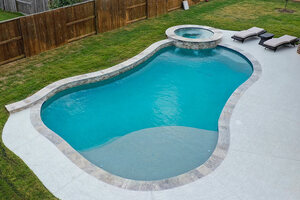Natural Pools: What to Know about This Rising Trend
Body
When you think of swimming pools, you likely think of a concrete rectangle filled with chlorinated water. You probably remember the smell of the chlorine, and the sting in your eyes if you opened them underwater. These are all normal memories of swimming in a pool, but what if there was a natural, chemical-free option, more reminiscent of swimming in a pond? Well, there is. In recent years, natural pools have become a popular way to add a pool to your yard in a way that looks and feels like a nature-made swimming hole. Keep reading to learn what you need to know about this trend.
How Do They Stay Clean?
Your first question is likely “How do you keep a pool like this clean without using chemicals?” Unlike traditional pools that rely on chlorine or saltwater systems, natural pools use a combination of plants and biofilters to clean the water. These pools are typically divided into 2 sections: the swimming area and the regeneration zone, where aquatic plants and microorganisms thrive. It’s this regeneration zone that does all the cleaning for your water.
The plants and bacteria in the regeneration zone break down organic matter, which in turn purifies the water. This natural filtration system keeps the pool clean without the need for harsh chemicals. Water is circulated between the two zones by a pump, ensuring that the swimming area stays fresh and clear.
Maintenance Requirements
The primary maintenance requirement in a chlorine pool is keeping the chemicals balanced. So, what does a chemical-free pool entail in terms of maintenance? While they are self-sustaining to a degree, they still have some maintenance tasks you’ll need to stay on top of. The primary task you’ll need to fulfill is ensuring that the regeneration zone remains healthy and balanced. This includes trimming plants, removing debris, and sometimes adding beneficial bacteria to the water.
The swimming area will also need routine cleaning, like removing leaves and algae buildup, which can be done with a vacuum—just as you’d clean a chlorinated pool. Regular checks of the pump and filtration system are necessary for a natural pool as well. Overall, this pool type will require about the same amount of maintenance as a chlorinated pool, as you’ll be “balancing” the ecosystem on a regular basis just like you’d regularly balance pool chemicals.









Comments